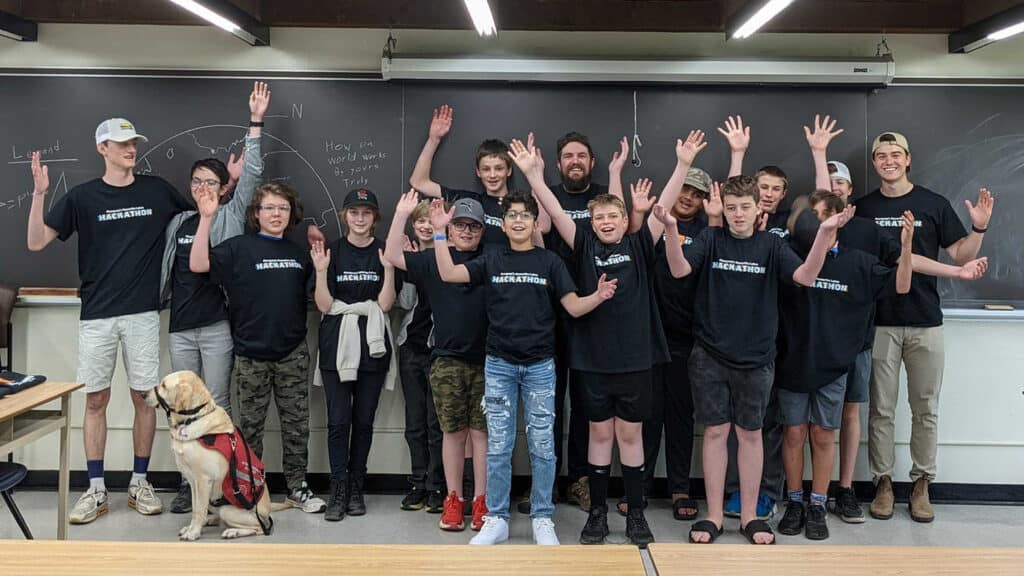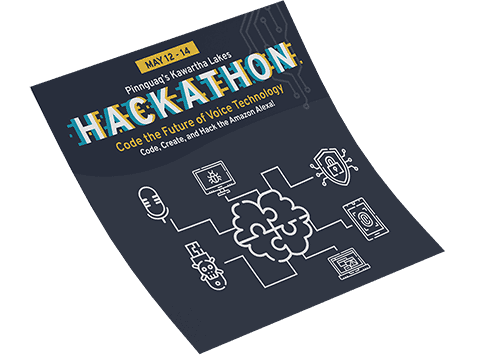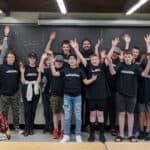with Aiden Mackey, Callum Penney, and Tanner Big Canoe
By Chelsea Kowalski
In May 2023, Pinnguaq hosted the first-ever Kawartha Lakes Hackathon: Code the Future of Voice Technology for high school students. In teams of two, 12 students competed at the Lindsay Makerspace over two-and-a-half days of intense learning, hacking, and presentation. For this hackathon, the goal was to come up with an idea for a new Alexa skill and code it using the beginner-friendly MIT App Inventor platform. Every participant left with an Alexa to continue their coding initiatives post-hackathon. This year’s winning team, Callum Penney and Aiden Mackey, respectively aged 11 and 12 at the time, came up with the brilliant idea of an Alexa-powered digital scavenger hunt.
Callum and Aiden, bright young students in Grade 7, spoke to Root & STEM about their experience as hackathon participants and explained what coding means to them.

In your own words, what is a hackathon?
Aiden: A fun event where everyone is working together and having a competition to see who’s the best even though everyone is good.
What did you create?
Callum: You ask Alexa to play the game by saying aloud, “Play online scavenger hunt.” Alexa then gives you the instructions to go to Scratch, the site where we coded the game, and start the quiz. Then you have to do a quiz and if you get it right, you receive a random word to say back to Alexa. Once you complete all the rounds, you get a choice of songs from Alexa and she will sing one that you choose.
What prior coding knowledge did you have and where did you learn it?
Callum: I actually knew a lot about Scratch and I learned it all through Pinnguaq.
Aiden: For me, I started coding young. The first time I made a project in Scratch, I was six. My brother Austin taught me and the Pinnguaq camps helped too.
What do you want teachers to know?
Callum: Coding is the future. The future is machinery, robots, self-driving cars. You need coding for that.
Aiden: Coding can seriously step up art and our creative careers because you can make stuff, you can animate, you can show people things. You can make people happy. It’s a lot of fun. And in my opinion, it’s very important.
What’s your advice for kids who want to participate in a hackathon like you did?
Callum: After the basics, you can fly right through it. Do what you want and make sure that it’s creative. Use your brain.
Aiden: As hard as it seems, once you get the basics down, it’s really easy. You just need to get the basics down on your phone.
Have you done any coding since the hackathon?
Aiden: I have younger cousins so I made a code so Alexa will read them a bedtime story. I found stories online and they can pick which one they want every time before bed. I even ask them if they want me or Alexa to read the bedtime story and they always ask for Alexa!
We also spoke with Tanner Big Canoe, a junior software developer who co-organized the hackathon and led the efforts to bring a coding competition to teens and pre-teens in Lindsay, Ontario
As an organizer, how would you describe a hackathon?
The best way to describe it would be a bunch of creative people coming together to solve a problem. In this case, we had a specific problem set out, but sometimes there are multiple prompts and you can choose whichever you find most interesting. You work in a small team usually and you cultivate those teamwork skills. Then you just blast through the competition days, which are usually 48 to 72 hours. Sometimes you’re just writing code and sometimes you’re developing a layout for a potential solution to the prompt. Once it’s finished, all the teams present their solutions to the judging panel. The judges have certain criteria that they use and if you have the best project, you get the prize at the end.
Why did you use voice technology, specifically Amazon’s Alexa, as the main component?
Everybody is developing apps and websites, but there are really cool avenues of new technology that don’t get as much attention. In this case, instead of doing the typical prompt of getting kids to build an app, website, or game, we thought about innovative ways to introduce them to something new and develop a skill that is not focused on as much. We had them interact with Alexa, which is a smart speaker, and asked them to build whatever they thought would be useful or fun for them.
Were there submissions that didn’t win but were still quite memorable?
Yes. One team was really into fashion and wanted to make sure that they didn’t wear the same clothes every day. They programmed Alexa to have access to a database of their clothes and what they wore for the week so that they could ask Alexa in the morning, “Alexa, what should I wear today?” Alexa would give them a recommendation based on the weather and different data points. It seemed like a super-efficient way to pick your clothes in the morning.
What did the judges look for in the winning project?
Overall, the judges were looking for teamwork, creativity, usefulness, how fun it was, and a polished look. We specifically made sure the participants could use both the MIT App Inventor and Alexa but we didn’t say they couldn’t use other technologies. Both Aiden and Callum had quite a bit of knowledge in Scratch that they integrated which added a visual aspect.
How can a hackathon be a good opportunity for competitors to network or make friendships?
Because there is a limited amount of time—in our case, just over 14 hours—we provided a format for time and project management but a lot of teams chose to do it their own way and assign roles and come together at the end. Just participating in a hackathon looks great and shows the ability to hunker down, get work done, and do it in a collaborative way. On the social side, it was pretty fun. We wanted a competition feeling but also a friendly, wholesome environment. By the end of it, a lot of parents from the same area facilitated more hangouts for their kids. We got to see them make friends not just during the hackathon and outside of it.
Do you have any advice for someone who wants to participate in a hackathon for the first time?
Just jump into it. The biggest obstacle is feeling like you don’t have the necessary skills to solve problems or be a part of a team. What I have learned from hackathons is that so many skills beyond coding are needed. Maybe you have great instincts for marketing or organization. Maybe you are just a great leader. For anyone worried about finding a team or fitting in, the organizers can help with that, find the right team for you, and make sure you have a great experience. That’s what we tried to do.
The MAKE section of Root & STEM showcases the different ways educators engage with students and promote STEAM concepts inside and outside the classroom. If you know of an educator who goes the extra mile, tell us about them at STEAM@pinnguaq.com.


